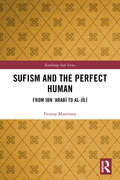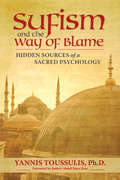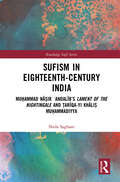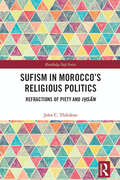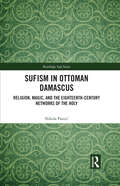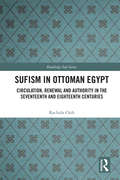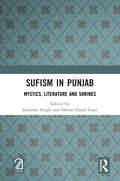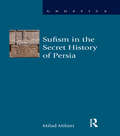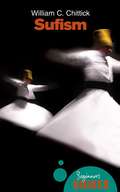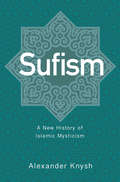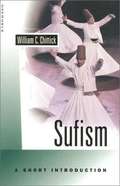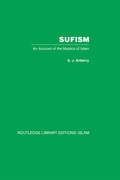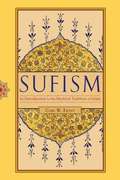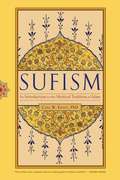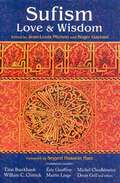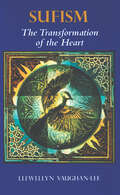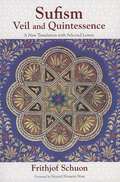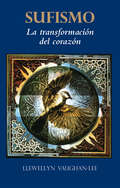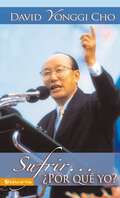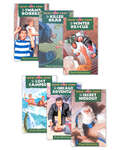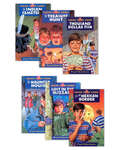- Table View
- List View
Sufism and the Perfect Human: From Ibn ‘Arabī to al-Jīlī (Routledge Sufi Series)
by Fitzroy MorrisseyStudying the history of the notion of the ‘Perfect Human’ (al-insān al-kāmil), this book investigates a key idea in the history of Sufism. First discussed by Ibn ‘Arabī and later treated in greater depth by al-Jīlī, the idea left its mark on later Islamic mystical, metaphysical, and political thought, from North Africa to Southeast Asia, up until modern times. The research tells the story of the development of that idea from Ibn ‘Arabī to al-Jīlī and beyond. It does so through a thematic study, based on close reading of primary sources in Arabic and Persian, of the key elements of the idea, including the idea that the Perfect Human is a locus of divine manifestation (maẓhar), the concept of the ‘Pole’ (quṭb) and the ‘Muhammadan Reality’ (al-ḥaqīqah al-Muhammadiyyah), and the identity of the Perfect Human. By setting the work of al-Jīlī against the background of earlier Ibn ‘Arabian treatments of the idea, it demonstrates that al-Jīlī took the idea of the Perfect Human in several new directions, with major consequences for how the Prophet Muhammad – the archetypal Perfect Human – was viewed in later Islamic thought. Introducing readers to the key Sufi idea of the Perfect Human (al-insān al-kāmil), this volume will be of interest to scholars and students interested in Sufism, Islam, religion and philosophy.
Sufism and the Way of Blame
by Robert Abdul Darr Yannis ToussulisThis is a definitive book on the Sufi "way of blame" that addresses the cultural life of Sufism in its entirety. Originating in ninth-century Persia, the "way of blame" (Arab. malamatiyya) is a little-known tradition within larger Sufism that focused on the psychology of egoism and engaged in self-critique. Later, the term referred to those Sufis who shunned Islamic literalism and formalism, thus being worthy of "blame." Yannis Toussulis may be the first to explore the relation between this controversial movement and the larger tradition of Sufism, as well as between Sufism and Islam generally, throughout history to the present. Both a Western professor of the psychology of religion and a Sufi practitioner, Toussulis has studied malamatiyya for over a decade. Explaining Sufism as a lifelong practice to become a "perfect mirror in which God contemplates Himself," he draws on and critiques contemporary interpretations by G. I Gurdjieff, J. G. Bennett, and Idries Shah, as well as on Frithjof Schuon, Martin Lings, and Seyyed Hossein Nasr. He also contributes personal research conducted with one of the last living representatives of the way of blame in Turkey today, Mehmet Selim Ozic.
Sufism and the Way of Blame
by Robert Abdul Darr Yannis ToussulisThis is a definitive book on the Sufi "way of blame" that addresses the cultural life of Sufism in its entirety. Originating in ninth-century Persia, the "way of blame" (Arab. malamatiyya) is a little-known tradition within larger Sufism that focused on the psychology of egoism and engaged in self-critique. Later, the term referred to those Sufis who shunned Islamic literalism and formalism, thus being worthy of "blame." Yannis Toussulis may be the first to explore the relation between this controversial movement and the larger tradition of Sufism, as well as between Sufism and Islam generally, throughout history to the present. Both a Western professor of the psychology of religion and a Sufi practitioner, Toussulis has studied malamatiyya for over a decade. Explaining Sufism as a lifelong practice to become a "perfect mirror in which God contemplates Himself," he draws on and critiques contemporary interpretations by G. I Gurdjieff, J. G. Bennett, and Idries Shah, as well as on Frithjof Schuon, Martin Lings, and Seyyed Hossein Nasr. He also contributes personal research conducted with one of the last living representatives of the way of blame in Turkey today, Mehmet Selim Ozic.
Sufism in Eighteenth-Century India: Muḥammad Nāṣir ʿAndalīb’s Lament of the Nightingale and Ṭarīqa-yi Khāliṣ Muḥammadiyya (Routledge Sufi Series)
by Neda SaghaeeSufism in Eighteenth-Century India focuses on one particular treasure from surviving Persian manuscripts in India, Nāla-yi ʿAndalīb, written by Muḥammad Nāṣir ʿAndalīb (d. 1759), a Naqshbandī Mujaddidī mystical thinker. It explores the convergence and interrelation of the text with its context to find how ʿAndalīb revisits the central role of the Prophet as the main protagonist in his allegorical love story with great attention to the circumstances of the Muslim community during the eighteenth century. The present volume elucidates ʿAndalīb’s Sufism calling for a return to the pristine form of Islam and the idealization of the first Muslim community. It considers his Ṭarīqa-yi Khāliṣ Muḥammadiyya as a derivation of the Ṭarīqa-yi Muḥammadiyya, which had an important role in promoting Islam. The book attempts to clarify and systematize all of the concepts which ʿAndalīb employs within the framework of the Khāliṣ Muḥammadiyya, such as the state of the nāṣir and the Khāliṣ Muḥammadī. It addresses controversial topics in religion, such as the struggles between Shiʿa and Sunni Muslims, and the controversies between Shuhūdīs and Wujūdīs. It illuminates two key personalities, Abū Bakr al-Ṣiddīq and ʿAlī b. Abī Ṭālib, and two types of relationships, the maʿiyya and ʿayniyya, with the spirituality of the Prophet. The book will be of interest to scholars and students interested in Islamic studies, Islamic mysticism, the intellectual history of Muslims in South Asia, the history of the Mughal Empire, Persian literature, studies of manuscripts, Islamic philosophy, comparative studies of religions, social studies, anthropology, and debates concerning the eighteenth century, such as the transition from pre-colonialism to colonialism and the origins of modernity in Islam.
Sufism in Morocco's Religious Politics: Refractions of Piety and Iḥsān (Routledge Sufi Series)
by John C. ThibdeauThis book outlines the role of Sufism in Moroccan politics in the twenty-first century through a comparative study of contemporary Sufi organizations. The author begins his analysis by highlighting the strategies employed by the Moroccan state over the past twenty years, aimed at regulating and producing an authorized ‘Moroccan Islam’ in the kingdom. Despite these policies of spiritual security and spiritual diplomacy, including the state sponsorship of Sufi organizations, the author argues that this has not decreased diversity nor produced a banal interpretation of Islam, but rather given rise to diverse articulations and performances of this religiosity. Through a comparative analysis of three Sufi organizations based on eighteen months of fieldwork – two of which have never before been studied – the author brings into relief the spaces of creative enactment of Sufism as an ethical tradition. Ultimately, it is argued that each Sufi organization reflects a different refraction of iḥsān, a concept emphasising the cultivation of public piety which underpins the Moroccan state’s formulation of Islam. Focused on both theoretical contributions to Islamic studies and topical treatments of geopolitical issues like spiritual diplomacy, the Western Sahara, and Morocco-Algeria, the book spans multiple disciplines, including anthropology, religious studies, sociology, and political science.
Sufism in Ottoman Damascus: Religion, Magic, and the Eighteenth-Century Networks of the Holy (Routledge Sufi Series)
by Nikola PantićSufism in Ottoman Damascus analyzes thaumaturgical beliefs and practices prevalent among Muslims in eighteenth-century Ottoman Syria. The study focuses on historical beliefs in baraka, which religious authorities often interpreted as Allah's grace, and the alleged Sufi-ulamaic role in distributing it to Ottoman subjects. This book highlights considerable overlaps between Sufis and ʿulamāʾ with state appointments in early modern Province of Damascus, arguing for the possibility of sociologically defining a Muslim priestly sodality, a group of religious authorities and wonder-workers responsible for Sunni orthodoxy in the Ottoman Empire. The Sufi-ʿulamāʾ were integral to Ottoman networks of the holy, networks of grace that comprised of hallowed individuals, places, and natural objects. Sufism in Ottoman Damascus sheds new light on the appropriate scholarly approach to historical studies of Sufism in the Ottoman Empire, revising its position in official early modern versions of Ottoman Sunnism. This book further re-approaches early modern Sunni beliefs in wonders and wonder-working, as well as the relationship between religion, thaumaturgy, and magic in Ottoman Sunni Islam, historical themes comparable to other religions and other parts of the world.
Sufism in Ottoman Egypt: Circulation, Renewal and Authority in the Seventeenth and Eighteenth Centuries (Routledge Sufi Series)
by Rachida ChihThis book analyses the development of Sufism in Ottoman Egypt, during the seventeenth and eighteenth centuries. Examining the cultural, socio-economic and political backdrop against which Sufism gained prominence, it looks at its influence in both the institutions for religious learning and popular piety. The study seeks to broaden the observed space of Sufism in Ottoman Egypt by placing it within its imperial and international context, highlighting on one hand the specificities of Egyptian Sufism, and on the other the links that it maintained with other spiritual traditions that influenced it. Studying Sufism as a global phenomenon, taking into account its religious, cultural, social and political dimensions, this book also focuses on the education of the increasing number of aspirants on the Sufi path, as well as on the social and political role of the Sufi masters in a period of constant and often violent political upheaval. It ultimately argues that, starting in medieval times, Egypt was simultaneously attracting foreign scholars inward and transmitting ideas outward, but these exchanges intensified during the seventeenth and eighteenth centuries as a result of the new imperial context in which the country and its people found themselves. Hence, this book demonstrates that the concept of ‘neosufism’ should be dispensed with and that the Ottoman period in no way constituted a time of decline for religious culture, or the beginning of a normative and fundamentalist Islam. Sufism in Ottoman Egypt provides a valuable contribution to the new historiographical approach to the period, challenging the prevailing teleology. As such, it will prove useful to students and scholars of Islam, Sufism and religious history, as well as Middle Eastern history more generally.
Sufism in Punjab: Mystics, Literature and Shrines
by Surinder Singh Ishwar Dayal GaurThis anthology is a collective endeavor of scholars from India and Pakistan devoted to Sufi mystics, literature and shrines with a detailed introduction. The essays explore the methods adopted by the Punjab Sufis to popularize the mystic ideology and praxis in the medieval socio-cultural milieu. These writings also delve into the different genres of Sufi literature, both in the elite and vernacular languages, intending to appreciate the nuances of Punjab Sufism. Apart from the architectural features of the Sufi shrines, the anthology attempts to illumine the organic linkages between these institutions and the Punjabis and, thus, underscore the Sufi non-communitarian devotion as a primary ingredient of the Punjabi cultural fusion. This title is co-published with Aakar Books. Print editions not for sale in South Asia (India, Sri Lanka, Nepal, Bangladesh, Pakistan and Bhutan)
Sufism in the Secret History of Persia: Sufism In The Secret History Of Persia (Gnostica)
by Milad MilaniSufism formed one of the cultures of resistance which has existed in the social fabric of Persia since antiquity. Such resistance continues to manifest itself today with many looking to Sufism as a model of cooperation between East and West, between traditional and modern. 'Sufism in the Secret History of Persia' explores the place of Sufi mysticism in Iran's intellectual and spiritual consciousness through traditional and contemporary Sufi thinkers and writers. Sufism in the Secret History of Persia examines the current of spirituality which extends from the old Iranian worship of Mithra to modern Islam. This current always contains elements of gnosis and inner knowing, but has often provided impetus for socio-political resistance. The study describes how these persisting pre-Islamic cultural and socio-religious elements have secretly challenged Muslim orthodoxies and continue to shape the nature and orientation of contemporary Sufism.
Sufism: A Beginner's Guide (Beginner's Guides #1)
by William C. ChittickWilliam C. Chittick, the leading scholar in the field, offers a compelling insight into the origins, context, and key themes of this fascinating movement. After a general overview of the tradition, he draws upon the words of some of the greatest Sufi writers - among them Ibn Arabi, Baha Walad and Rumi himself - to give a fresh and revealing perspective on the teachings and beliefs of Sufism and its proponents. Covering everything from the history and growth of Sufism to its place in the modern world, this sympathetic book will be appreciated by anyone interested in Sufism, from complete beginners to students, scholars and experts alike.
Sufism: A New History of Islamic Mysticism
by Alexander KnyshA pathbreaking history of Sufism, from the earliest centuries of Islam to the presentAfter centuries as the most important ascetic-mystical strand of Islam, Sufism saw a sharp decline in the twentieth century, only to experience a stunning revival in recent decades. In this comprehensive new history of Sufism from the earliest centuries of Islam to today, Alexander Knysh, a leading expert on the subject, reveals the tradition in all its richness.Knysh explores how Sufism has been viewed by both insiders and outsiders since its inception. He examines the key aspects of Sufism, from definitions and discourses to leadership, institutions, and practices. He devotes special attention to Sufi approaches to the Qur’an, drawing parallels with similar uses of scripture in Judaism and Christianity. He traces how Sufism grew from a set of simple moral-ethical precepts into a sophisticated tradition with professional Sufi masters (shaykhs) who became powerful players in Muslim public life but whose authority was challenged by those advocating the equality of all Muslims before God. Knysh also examines the roots of the ongoing conflict between the Sufis and their fundamentalist critics, the Salafis—a major fact of Muslim life today.Based on a wealth of primary and secondary sources, Sufism is an indispensable account of a vital aspect of Islam.
Sufism: A Short Introduction
by William C. ChittickThe Sufi tradition, commonly associated with the Whirling Dervishes and beautiful poetry of the great mystic Rumi, is introduced here in this new guide. William C. Chittick, the leading scholar in this field, offers a compelling insight into the origins, context, and key themes of this movement. After a general overview of the tradition, he draws upon the words of some of the greatest Sufi writers to give a fresh and revealing perspective on the teaching and beliefs of Sufism and its proponents.
Sufism: An Account of the Mystics of Islam
by A.J. ArberryOriginally published in 1950.Thinkers such as Ghazali and Ibn `Arabi, poets such as Ibn al-Farid, Rumi, Hafiz and Jami were greatly inspired by the lives and sayings of the early Sufis. This book was the first short history of Sufism to be published in any language, illustrating the development of its doctrines with numerous quotations from literature.
Sufism: An Introduction to the Mystical Tradition of Islam
by Carl W. ErnstThe Sufis are as diverse as the countries in which they've flourished--from Morocco to India to China--and as varied as their distinctive forms of art, music, poetry, and dance. They are said to represent the mystical heart of Islam, yet the term Sufism is notoriously difficult to define, as it means different things to different people both within and outside the tradition. With that fact in mind, Carl Ernst explores the broadest range of Sufi philosophies and practices to provide one of the most complete and comprehensive introductions to Sufism available in English. He traces the history of the movement from the earliest days of Islam to the present day, along the way examining its relationship to the larger world of Islam and its encounters with both fundamentalism and secularism in the modern world.
Sufism: An Introduction to the Mystical Tradition of Islam (Routledge Sufi Ser. #No.4)
by Carl W. ErnstThe Sufis are as diverse as the countries in which they've flourished—from Morocco to India to China—and as varied as their distinctive forms of art, music, poetry, and dance. They are said to represent the mystical heart of Islam, yet the term Sufism is notoriously difficult to define, as it means different things to different people both within and outside the tradition. With that fact in mind, Carl Ernst explores the broadest range of Sufi philosophies and practices to provide one of the most complete and comprehensive introductions to Sufism available in English. He traces the history of the movement from the earliest days of Islam to the present day, along the way examining its relationship to the larger world of Islam and its encounters with both fundamentalism and secularism in the modern world.
Sufism: Love and Wisdom
by Roger Gaetani Jean-Louis MichonFor hundreds of years, the inner spiritual core of Islam has been the focus of Sufi thinkers. These essays allow the reader to understand the wisdom and history of Sufism.
Sufism: The Transformation of the Heart
by Llewellyn Vaughan-LeeSufism, the Transformation of the Heart gives a clear and accessible outline of Sufism: its basic principles, historical background, and recent development in the West. While exploring the spiritual and psychological processes of transformation, this book offers practical guidelines to help the seeker. Sufism, the Transformation of the Heart is a valuable introduction to a dynamic spiritual path that is attracting growing interest in the West.
Sufism: Veil and Quintessence A New Translation with Selected Letters
by Seyyed Hossein Nasr Frithjof Schuon James CutsingerThis new edition of Frithjof Schuon's important work, Sufism: Veil and Quintessence, is a fully revised translation from the French original and has an extensive Appendix containing previously unpublished letters and other private writings.
Sufismo
by Llewellyn Vaughan-LeeA lucid approach to Sufism, this exploration seeks to inform the Spanish-speaking Western world about this Eastern spiritual tradition. While elaborating on Sufism's inextricable link to Islam and the prophet Muhammad's spiritual experience, this book goes even further to explore the different ways in which Sufi mysticism exceeds the scope of Islamic orthodoxy. Written by a Sufi scholar and musician, this study is sure to appeal to fellow religious scholars as well as casual readers curious about Eastern religions and philosophies.Un acercamiento lÚcido al sufismo, esta exploraciÓn busca informar al mundo occidental hispanohablante acerca de esta tradiciÓn espiritual oriental. Mientras explica en detalle la conexiÓn innegable entre el sufismo y el Islam y la experiencia espiritual del profeta Mahoma, este libro va aÚn mÁs allÁ para explorar las diferentes maneras en las cuales el misticismo sufÍ excede el alcance de la ortodoxia islÁmica. Escrito por un acadÉmico y mÚsico sufÍ, este estudio seguramente atraerÁ a otros acadÉmicos religiosos al igual que a lectores curiosos sobre las religiones y filosofÍas orientales.
Sufrir...¿Por qué yo?
by Pastor David Yonggi ChoEsta obra se basa en el testimonio personal del autor. Padeció de enfermedades dolorosas indescriptibles, incluso un caso muy crítico de tuberculosis, un colapso nervioso, problemas cardiacos y una dolencia estomacal que requirió una operación complicada. Muchas veces pasó por el valle de la muerte. Cada vez que tuvo que guardar cama, escudriñó la Palabra de Dios con la firme determinación de conquistar las enfermedades por la gracia de Dios.
Sugar Creek Gang Series Books 1-36 (Sugar Creek Gang Original Series)
by Paul HutchensThis set includes the entire collection of the Sugar Creek Gang Series, books 1-36.The Sugar Creek Gang series chronicles the faith-building adventures of a group of fun-loving, courageous Christian boys. These classic stories have been inspiring children to grow in their faith for more than five decades. More than three million copies later, children continue to grow up relating to members of the gang as they struggle with the application of their Christian faith to the adventure of life. Now that these stories have been updated for a new generation, you and your child can join in the Sugar Creek excitement. Paul Hutchens' memories of childhood adventures around the fishing hole, the swimming hole, the island, and the woods that surround Indiana's Sugar Creek inspired these beloved tales.
Sugar Creek Gang Series Books 1-36 (Sugar Creek Gang Original Series)
by Paul HutchensThis set includes the entire collection of the Sugar Creek Gang Series, books 1-36.The Sugar Creek Gang series chronicles the faith-building adventures of a group of fun-loving, courageous Christian boys. These classic stories have been inspiring children to grow in their faith for more than five decades. More than three million copies later, children continue to grow up relating to members of the gang as they struggle with the application of their Christian faith to the adventure of life. Now that these stories have been updated for a new generation, you and your child can join in the Sugar Creek excitement. Paul Hutchens' memories of childhood adventures around the fishing hole, the swimming hole, the island, and the woods that surround Indiana's Sugar Creek inspired these beloved tales.
Sugar Creek Gang Set Books 1-6 (Sugar Creek Gang Original Series)
by Paul HutchensThis set includes books 1-6 in the Sugar Creek Gang Series: The Swamp Robber, The Killer Bear, The Winter Rescue, The Lost Campers, The Chicago Adventure, and The Secret Hideout.The tales and travels of the Sugar Creek Gang have passed the test of time, delighting young readers for more than fifty years. Great mysteries for kids with a message, The Sugar Creek Gang series chronicles the faith-building adventures of a group of fun-loving, courageous Christian boys. Your kids will be thrilled, chilled, and inspired to grow as they follow the legendary escapades of Bill Collins, Dragonfly, and the rest of the gang as they struggle with the application of their Christian faith to the adventure of life. In The Swamp Robber, the Sugar Creek Gang discovers a "disguise" hidden in a old tree. Does it belong to the bank robber hiding in the swamp? A mysterious map hidden near the tree proves to be even more exciting than the disguise. Before the adventure ends, the gang encounters the robber, helps Bill Collins welcome a new baby sister, and saves the victim of a black widow spider bite. Join the gang as they learn the lesson of "sowing and reaping". In The Killer Bear, Circus" Brown's father makes a life-changing decision at a revival meeting. Will he be able to stay on the narrow path? Back in the woods, the mean Till boys and the Sugar Creek Gang wrestle over a patch of wild strawberries. This leads to an encounter with an angry black bear. Join the gang as they learn to apply the lesson of forgiving seventy times seven in the face of great danger.In The Winter Rescue, the last swim of the summer ends miserably for the Sugar Creek Gang when someone steals Little Jim's pet baby bear. The search for the missing bear cub takes the gang through the woods to Old Man Paddler's cabin. When winter arrives, the boys return to the cabin, where they receive a startling surprise. Join the gang as they discover the power of prayer.In The Lost Campers, Bill Collins and Little Jim survive a wild ride on the flooded Sugar Creek thanks to the acrobatic efforts of their friend "Circus". When summer arrives, the gang heads to Pass Lake, Minnesota, for a camping trip. There they discover a railroad coach in the middle of a forest without any tracks, and an honest-to-goodness American Indian with beads and a war bonnet. Join the gang as the experience the meaning of being saved, both physically and spiritually. In The Chicago Adventure, the Sugar Creek Gang's adventure to Chicago is full of ups and downs. It starts with an airplane ride over a storm. The adventure includes museum visits, rescue mission ministry, performing on the radio at Moody Bible Institute, and an elevated train ride. A fight between Jim and Bob Till lands one of them in the hospital in critical condition. Join the Gang as they learn again that the only way to heaven is through Jesus. In The Secret Hideout, "Poetry" brings his muddy lamb into Miss Lilly's classroom, and chaos breaks out. The gang later discovers a mysterious cave with a hidden passage near the cemetery. When they spend the night in the cave, they are frightened by two very different visitors dressed in white. Could they be ghosts? Join the gang as Poetry's pet lamb provides a helpful explanation of Jesus' parable of the lost sheep.
Sugar Creek Gang Set Books 1-6 (Sugar Creek Gang Original Series)
by Paul HutchensThis set includes books 1-6 in the Sugar Creek Gang Series: The Swamp Robber, The Killer Bear, The Winter Rescue, The Lost Campers, The Chicago Adventure, and The Secret Hideout.The tales and travels of the Sugar Creek Gang have passed the test of time, delighting young readers for more than fifty years. Great mysteries for kids with a message, The Sugar Creek Gang series chronicles the faith-building adventures of a group of fun-loving, courageous Christian boys. Your kids will be thrilled, chilled, and inspired to grow as they follow the legendary escapades of Bill Collins, Dragonfly, and the rest of the gang as they struggle with the application of their Christian faith to the adventure of life. In The Swamp Robber, the Sugar Creek Gang discovers a "disguise" hidden in a old tree. Does it belong to the bank robber hiding in the swamp? A mysterious map hidden near the tree proves to be even more exciting than the disguise. Before the adventure ends, the gang encounters the robber, helps Bill Collins welcome a new baby sister, and saves the victim of a black widow spider bite. Join the gang as they learn the lesson of "sowing and reaping". In The Killer Bear, Circus" Brown's father makes a life-changing decision at a revival meeting. Will he be able to stay on the narrow path? Back in the woods, the mean Till boys and the Sugar Creek Gang wrestle over a patch of wild strawberries. This leads to an encounter with an angry black bear. Join the gang as they learn to apply the lesson of forgiving seventy times seven in the face of great danger.In The Winter Rescue, the last swim of the summer ends miserably for the Sugar Creek Gang when someone steals Little Jim's pet baby bear. The search for the missing bear cub takes the gang through the woods to Old Man Paddler's cabin. When winter arrives, the boys return to the cabin, where they receive a startling surprise. Join the gang as they discover the power of prayer.In The Lost Campers, Bill Collins and Little Jim survive a wild ride on the flooded Sugar Creek thanks to the acrobatic efforts of their friend "Circus". When summer arrives, the gang heads to Pass Lake, Minnesota, for a camping trip. There they discover a railroad coach in the middle of a forest without any tracks, and an honest-to-goodness American Indian with beads and a war bonnet. Join the gang as the experience the meaning of being saved, both physically and spiritually. In The Chicago Adventure, the Sugar Creek Gang's adventure to Chicago is full of ups and downs. It starts with an airplane ride over a storm. The adventure includes museum visits, rescue mission ministry, performing on the radio at Moody Bible Institute, and an elevated train ride. A fight between Jim and Bob Till lands one of them in the hospital in critical condition. Join the Gang as they learn again that the only way to heaven is through Jesus. In The Secret Hideout, "Poetry" brings his muddy lamb into Miss Lilly's classroom, and chaos breaks out. The gang later discovers a mysterious cave with a hidden passage near the cemetery. When they spend the night in the cave, they are frightened by two very different visitors dressed in white. Could they be ghosts? Join the gang as Poetry's pet lamb provides a helpful explanation of Jesus' parable of the lost sheep.
Sugar Creek Gang Set Books 13-18 (Sugar Creek Gang Original Series)
by Paul HutchensThis set includes books 13-18 in the Sugar Creek Gang Series: The Indian Cemetery, The Treasure Hunt, The Thousand Dollar Fish, The Haunted House, Lost in the Blizzard, and On the Mexican Border.The tales and travels of the Sugar Creek Gang have passed the test of time, delighting young readers for more than fifty years. Great mysteries with a message, The Sugar Creek Gang series chronicles the faith-building adventures of a group of fun-loving, courageous Christian boys. Your kids will be thrilled, chilled, and inspired to grow as they follow the legendary escapades of Bill Collins, Dragonfly, and the rest of the gang and see how they struggle with the application of their Christian faith to the adventure of life. In The Indian Cemetery, it's another adventure in Minnesota's Lake Country! Could the mysterious man wandering around the Indian cemetery at night with a tackle box have anything to do with the kidnapped Ostberg girl? Or could it be the other mysterious man with dark glasses and a white boat? Discover with the Sugar Creek Gang what the Bible says about death and eternal life.In The Treasure Hunt, a mysterious note in invisible ink leads the Sugar Creek Gang on a hunt for buried treasure. Is the key to the treasure in the weathered log house, or is it in the icehouse? Will the gang have a run-in with the accomplice to the Ostberg kidnapping? Find out with the boys the terrible effects sin has on families when it has a hold on the father. In The Thousand Dollar Fish, an incredible discovery in an icehouse leads to an encounter with a criminal. Will the police come quickly enough to catch the man the gang trapped? Will the gang be able to deliver an important letter from Little Tom Till's mom before it's too late? In this tale from northern Minnesota, the gang learns about several kinds of fishing, the most important being fishing for men.In The Haunted House, way up on a hill on Old Man Paddler's property stands an old house that many people think is haunted. A late night raccoon hunt with dogs from Circus's dad help the gang get to the bottom of the mystery. What will the boys discover in the dark attic of the haunted house? Reflect with Bill on the meaning of the Bible verse "... absent from the body... at home with the Lord". In Lost in the Blizzard, the gang has several exciting encounters with a hognose snake. A new member of the gang, Middle Jim, offers amazing insights into the snake mystery. When winter arrives, Middle Jim puts the whole gang in jeopardy. Will the boys survive the night in the fierce storm? Discover the important truth of the great hymn "A Mighty Fortress Is Our God". In On the Mexican Border, the gang enjoys a mid-winter vacation on the Rio Grande River. Their adventures include fishing in the Gulf of Mexico, meeting a boy evangelist, and chasing a criminal through a grapefruit grove. Will the stowaway in their trunk make it safely across the border? Learn with the Sugar Creek Gang how precious children of all colors are in God's sight.
